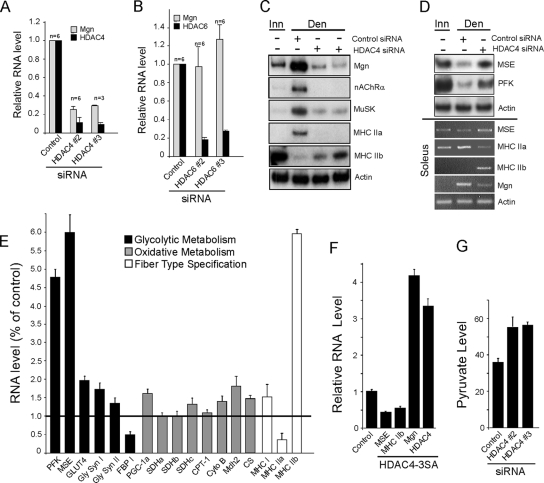Figure 2.
HDAC4 is necessary for denervation-dependent gene induction and suppression. Experiments were performed on adult innervated and denervated TA muscle except bottom panel in D, in which soleus muscle was used. Denervated muscles were electroporated with the indicated siRNAs (E; data from siRNAs targeting HDAC4) as described in Materials and Methods. (A and B) Quantitative real-time PCR showing that knockdown of HDAC4, but not HDAC6, prevents denervation-dependent Mgn mRNA induction. (C and D) Radioactive and qualitative PCR analysis showing HDAC4 regulates denervation-dependent gene expression in TA and soleus muscle. (E) Quantitative real-time PCR analysis of the effects of HDAC4 knockdown on the expression of genes involved in glycolytic and oxidative metabolism, and fiber-type specification in denervated TA muscle. Reported is the -fold change relative to the control siRNA electroporated muscle, n = 3. (F) Expression of nuclear localized HDAC4-3SA in innervated TA muscle represses MSE and MHC IIb mRNA levels and induces Mgn mRNA levels. Adult innervated TA muscle was electroporated with an HDAC4-3SA expression vector or an empty expression vector (control) and 12 d later the TA muscle was isolated for RNA analysis by real-time PCR. (G) HDAC4 knockdown in C2C12 muscle cells increases pyruvate production. Error bars are SDs, n = 6. In all studies using real-time PCR, gene expression values were normalized to γ-actin expression. FBP, fructose 2,6 bisphosphatase; GLUT4, glucose transporter 4; PGC-1α, peroxisome proliferators-activated receptorγ coactivator 1α; CPT-1, carnitine palmitoyltransferase-1; CytoB, cytochrome b; CS, citrate synthase.

